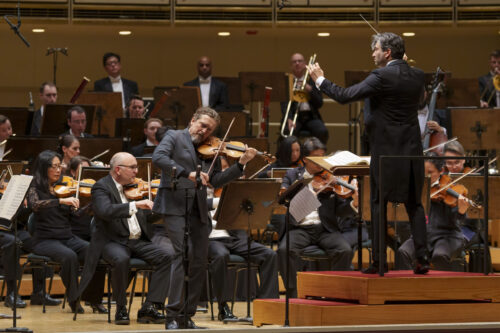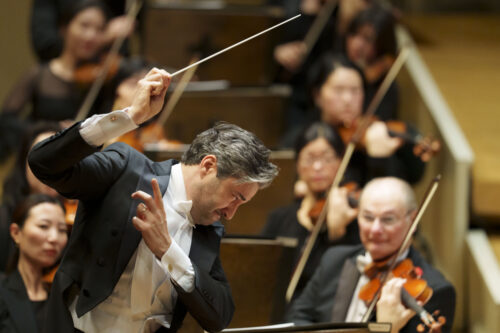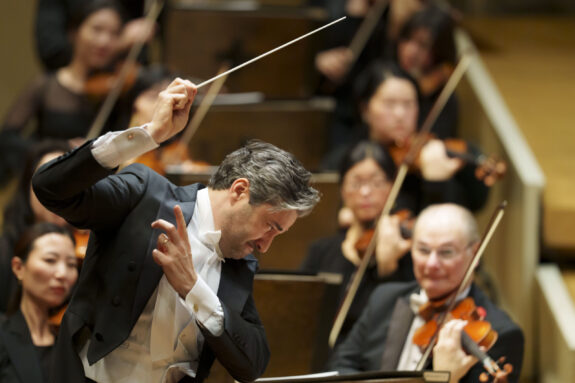 United States Wagner, Sibelius, Schoenberg: Christian Tetzlaff (violin), Chicago Symphony Orchestra / David Afkham (conductor). Orchestra Hall, Chicago, 14.2.2025. (ZC)
United States Wagner, Sibelius, Schoenberg: Christian Tetzlaff (violin), Chicago Symphony Orchestra / David Afkham (conductor). Orchestra Hall, Chicago, 14.2.2025. (ZC)

Wagner – Prelude to Act III of Lohengrin
Sibelius – Violin Concerto in D minor
Schoenberg – Pelleas und Melisande
Violinist Christian Tetzlaff and guest conductor David Afkham headlined the Chicago Symphony Orchestra’s concert series this weekend. The German duo presented a program of works by Richard Wagner, Jean Sibelius and Arnold Schoenberg – three selections that highlight the shifting landscape of classical music at the turn of the twentieth century.
Composed just a year apart, Sibelius’s Violin Concerto and Schoenberg’s Pelleas und Melisande reflect two distinct responses to the influence of Richard Wagner. A young Sibelius was deeply affected by Wagner’s music, particularly after experiencing Parsifal at Bayreuth. Although Sibelius attempted operatic composition, he shifted to orchestral works and initially retained traces of Wagner’s harmonic language and orchestration. But gradually, he developed a flourish-lite style focused on organic development and austere textures. Schoenberg, too, revered Wagner, particularly Tristan und Isolde. Pelleas und Melisande embodies both the height of late Romanticism and a pivot toward the composer’s more radical innovations. Schoenberg roots the piece with Wagnerian leitmotifs and expansive orchestration, but the work’s complex harmonic language hints at dissonances that would later become a staple of the composer’s music.
The Sibelius Violin Concerto was the featured piece in the first half of the concert. In part, this work reflects his unfulfilled ambition to become a virtuoso violinist before dedicating his career instead to composition. The concerto carries this personal history, blending technical challenges with expressive, haunting melodies. Tetzlaff, who has performed and recorded the work multiple times, brought a seasoned interpretation to the stage.
From the outset, Christian Tetzlaff’s smooth phrasing and tone captivated the audience, establishing the conditions for an impressive performance. He navigated the piece’s technical demands with seeming ease, delivering a performance of the first movement that was both adroit and spellbinding. Tetzlaff played the movement’s cadenza with such brilliance that the brief burst of applause felt inevitable. In the second movement, his emotionally distant approach provided an introspective quality that hung in the air. The final movement erupted with energy. Winds bubbled up, and timpani and Tetzlaff matched each other in dramatic fashion. As the piece rushed toward conclusion, Sibelius’s sweeps and swells felt like more than music.
The orchestra’s role in this concerto is Janus-like. Often, its players must support Tetzlaff but, especially in key parts of the outer movements, they could get the spotlight. Afkham led them with clear direction and unobtrusive presence, and they seized on the moments Sibelius gave them. Strings, winds and brass were especially good, and together they countered Tetzlaff’s virtuosity with their own. Equally impressive is how Afkham capitalized on the work’s wide dynamic ranges, drawing the listener in while establishing Sibelius’s often barren soundworld. His pacing allowed the piece to unfold naturally, maintaining momentum even in its more reflective sections. The result was a performance that left a lasting impression, setting a high standard for live interpretations of the work.

Schoenberg’s Pelleas und Melisande occupied the second half of the program, the first time in nearly two decades that it has been featured in Orchestra Hall. Friday’s performance coincided with celebrations of the 150th anniversary of the composer’s birth, and it was especially noteworthy after the recent loss of more than 100,000 archived scores in the Los Angeles wildfires.
Hearing Pelleas und Melisande in concert highlights the work’s place as a last gasp of the late Romanticism that Schoenberg ultimately left behind. It combines Wagnerian leitmotifs with the tone poem structure popularized by Richard Strauss. But this is a hard piece to love, for both audiences and musicians. Knowing the basic direction of the poem can help ground the listener, more so than trying to follow how Schoenberg deploys each leitmotif. His use of a large, post-Wagnerian orchestra can feel more cumbersome than expansive compared to how Mahler employs similarly enormous forces in the pieces he composed at roughly the same time. For all its romantic flourishes, the piece can come across as turgid in the wrong hands.
David Afkham’s approach emphasized structure and movement, helping the performance avoid stagnation. He kept the motifs and interwoven scenes fluid, allowing the work’s dramatic arc to surface. The orchestra met the score’s demands with commitment, shaping climaxes with force while maintaining warmth in the more delicate moments. The result was a performance that made the best case for Pelleas und Melisande, balancing its weighty textures with clarity and direction.
The concert began with Wagner’s Prelude to Act III of Lohengrin, a brief but energetic opening. The orchestra’s strings launched into the piece while the brass roared with a bold, resonant sound. Though it lasted only a few minutes, the prelude set a dramatic tone for the evening. Its sweeping momentum and rich orchestration provided a glimpse into the musical world that influenced both Sibelius and Schoenberg, connecting the program’s later works to the Wagnerian tradition and serving as a fitting introduction to the two divergent paths that followed.
Zach Carstensen
